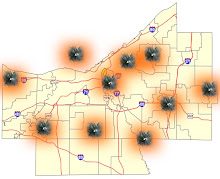How do you transform a loosely grouped ensemble of medical buildings into a "campus"?
Commandeer a major piece of city and federal infrastructure and transform the street, Euclid Avenue, into a organizational pedestrian spine. That is exactly what the Cleveland Clinic is studying and proposing.
The Clinic is a monster institution, possessing blocks and blocks of inner city Cleveland, abutting University Circle. The Clinic is the largest institution in the city and adds luster to the rusting hulk of this post-industrial region. To say the least, the hospital maintains a muscular presence.
Many were astounded by the brashness and scope of the plan, which would alter the urban landscape for over 20 city blocks. But this is in by no way a new tactic for institutions seeking to engender or further enhance the notion of "campus". Penn State turned a campus and State College Street into a Jefferson-inspired academic mall, a space now considered the main organizational element. Yale University has transformed New Haven streets into University campus walks, connecting Old Campus to Cross Campus and the Sterling Memorial Library. Case Western Reserve University has morphed alleys into student thoroughfares. And there are many other examples that escape me.
The scale of the endeavor is intriguing, as well as the retroactive urban design tactic that Peter Walker and the Clinic are employing. The deployment of a organizational element, a massive pedestrian mall, after over 90 years of campus development, overturns the normative methods of campus design. Instead of inducing the instant campus, the proposed plan suggests the acquisition of "campus" can be attained many decades after the planning and building begins.
Although the Clinic may be inciting a political firestorm, the methods and tactics that Peter Walker is employing are nonetheless interesting and deserve further critical scrutiny.
For more on the Clinic plan see Design Rag's take.
Subscribe to:
Post Comments (Atom)





No comments:
Post a Comment